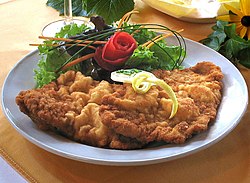Central European cuisine



Central European cuisine consists of the culinary customs, traditions and cuisines of the nations of Central Europe.
The cuisines within each country in the region is strongly influenced by the local climate. For example, German, Austrian and Swiss cuisines show many similarities, yet differ from the highlander cuisines in their respective countries, while in settlements closer to rivers or lakes, more fish and various seafood can be found more frequently. More mountainous areas near the Alps house dishes that contain cheese, milk and butter among other dairy products.[1]
While countries like Croatia, Czechia, Hungary, Lithuania, Poland, Slovakia, and Slovenia are often geographically classified as part of Central Europe, their cuisines differ notably from those of Austria, Germany, and Switzerland. Polish, Czech, Slovak, and Lithuanian cuisines are sometimes viewed as part of the Eastern European culinary sphere due to strong East Slavic influences. Meanwhile, Hungarian and Croatian cuisines are often associated with Southeastern Europe or the Balkans, reflecting Ottoman and South Slavic culinary traditions. Though Slovenia is geographically Central European, its cuisine leans more toward Alpine and Mediterranean influences, distinguishing it from the Balkan culinary identity.
Roman Empire influence
During the Bronze Age and Iron Age the basic foods were pulses, wild fruits and nuts, and cereals. Archaeobotanical evidence has shown that a large number of new foodstuffs were introduced to Central Europe under Roman rule, becoming incorporated into (rather than replacing) local culinary flavors. Because chickpeas, gourd, black pepper, pistachio, almond, dates, olives, melons and rice were difficult to cultivate locally they remained imported luxuries, out of reach for most. Evidence has been found for dill, celery seeds and other seasonings at Bibracte and other excavation sites.[2][3]
See also
- Ashkenazi cuisine
 Austrian cuisine
Austrian cuisine
 Czech cuisine
Czech cuisine
 German cuisine
German cuisine
 Hungarian cuisine
Hungarian cuisine Polish cuisine
Polish cuisine
 Liechtensteiner cuisine
Liechtensteiner cuisine Silesian cuisine
Silesian cuisine Slovak cuisine
Slovak cuisine Slovenian cuisine
Slovenian cuisine Swiss cuisine
Swiss cuisine
References
- ^ admin (2020-03-24). "Typical dishes for the Alpine region". Restaurant Fondue. Retrieved 2022-09-23.
- ^ Luxury: A Rich History. Oxford University Press. 2016. p. 21. ISBN 978-0-19-966324-8.
- ^ Fleming, Robin (11 June 2021). The Material Fall of Roman Britain. p. 206. ISBN 9780812297362.
- Metzger, Christine (ed.) Culinaria Germany. Cambridge: Ullmann, 2008.
- Montanari, Massimo, Il mondo in cucina (The world in the kitchen). Laterza, 2002
- Mintz, Sidney . Tasting Food, Tasting Freedom: Excursions into Eating, Power, and the Past, Beacon Press, 1997, ISBN 0807046299
- Mintalová - Zubercová, Zora: Všetko okolo stola I.(All around the table I.), Vydavateľstvo Matice slovenskej, 2009, ISBN 978-80-89208-94-4
